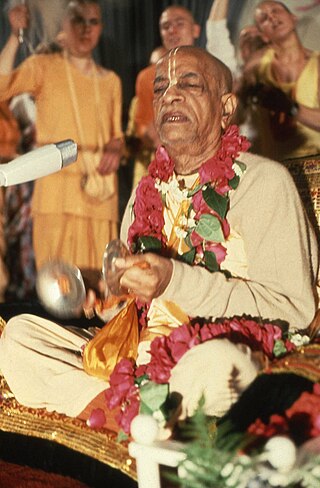
Abhay Charanaravinda Bhaktivedanta Swami Prabhupada was an Indian spiritual teacher who was the founder of the International Society for Krishna Consciousness (ISKCON), commonly known as the "Hare Krishna movement". Followers of ISKCON view Bhaktivedanta Swami Prabhupada as a representative and messenger of Chaitanya Mahaprabhu.

Kriyananda was an American Hindu religious leader, yoga guru, meditation teacher, musician, and author. He was a direct disciple of Paramahansa Yogananda and founder of the spiritual movement named "Ananda". He wrote numerous songs and dozens of books. According to the LA Times, the main themes of his work were compassion and humility, but he was a controversial figure. Kriyananda and Ananda were sued for copyright issues, sexual-harassment, and later, for alleged fraud and labor-law violations.

Dakshineswar Kali Temple or Dakshineswar Kalibari is a Hindu navaratna temple in Dakshineswar, Kolkata, West Bengal, India. Situated on the eastern bank of the Hooghly River, the presiding deity of the temple is Bhavatarini (Kali), a form of Mahadevi or Parashakti Adya Kali, otherwise known as Adishakti Kalika. The temple was built in 1855 by Rani Rashmoni, a Zamindar, philanthropist and a devotee of Kali Maa. The temple is known for its association with Ramakrishna and Ma Sarada Devi, mystics of 19th century Bengal.

Belur Math is the headquarters of the Ramakrishna Math and Ramakrishna Mission, founded by Swami Vivekananda, the chief disciple of Ramakrishna Paramahamsa. It is located in Belur, West Bengal, India on the west bank of Hooghly River. Belur Math was established in January 1897, by Swami Vivekananda who was the disciple of Sri Ramakrishna. Swami Vivekananda returned back to India from Colombo with a small group of disciples and started work on the two one at Belur, and the others at Mayavati, Almora, Himalayas called the Advaita Ashrama. The temple is the heart of the Ramakrishna movement. It is notable for its architecture that fuses Hindu, Islamic, Buddhist, and Christian art and motifs as a symbol of unity of all religions. In 2003, Belur Math railway station was also inaugurated which is dedicated to Belur Math Temple.

Vivekananda Rock Memorial is a monument and popular tourist attraction in Kanyakumari, India's southernmost tip. The memorial stands on one of the two rocks located about 500 meters off mainland of Vavathurai. It was built in 1970 in honour of Swami Vivekananda, who is said to have attained enlightenment on the rock. According to legends, it was on this rock that Goddess Kanyakumari (Parvathi) performed tapas in devotion of lord Shiva. A meditation hall known as Dhyana Mandapam is also attached to the memorial for visitors to meditate. The design of the mandapa incorporates different styles of temple architecture from all over India. The rocks are surrounded by the Laccadive Sea where the three oceans Bay of Bengal, the Indian Ocean and the Arabian Sea meets. The memorial consists of two main structures, the Vivekananda Mandapam and the Shripada Mandapam.

Sadasiva Brahmendra was a saint, composer of Carnatic music and Advaita philosopher and Sishya of the Great saint Shri Paramasivendra Sarasvati, who lived near Thiruvenkadu, Tamil Nadu, during the 15th/16th century. Even Today, many saints from big and small mathas come and prostrate at his adhisthanam to pay their respects to him and his guru parampara. Unfortunately only a few of his compositions have survived, but they are recognized as great compositions of Carnatic music.

Bhagat Sadhna, also called Sadhna Qasai, was a north Indian poet, saint, mystic and one of the devotees whose hymn was incorporated in Guru Granth Sahib. Venerated in the region of Punjab, among Sikhs and Ravidassias, his devotional hymn is widely quoted by most preachers. His one hymn is present in Adi Granth Sahib, in Raga Bilaval.
Dhulipala Sitarama Sastry, known mononymously by the surname Dhulipala, was an Indian actor and thespian, known for his works predominantly in Telugu cinema. He was noted for playing mythological roles, particularly the role of Shakuni. He began his acting career at the young age of 13 and went on to work in about 300 films. He shot to fame with Bhishma and Sri Krishna Pandaveeyam, acting alongside N. T. Rama Rao.
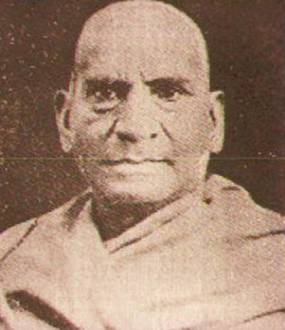
Swami Shraddhanand, also known as Mahatma Munshi Ram Vij, was an Arya Samaj sannyasi and an Indian Independence activist who propagated the teachings of Dayananda Saraswati. This included the establishment of educational institutions, like the Gurukul Kangri University, and played a key role on the Sangathan and the Shuddhi (purification), a Hindu reform movement in the 1920s.
Punkunnam Seetha Ramaswamy Temple more commonly called as 'Pushpagiri Seeta Ramaswamy temple' is located in the Pushpagiri agraharam of Punkunnam, Thrissur city of Kerala, India.
Itagi is a village in the southern state of Karnataka, India. It is located in the Rona taluk of Gadag district in Karnataka. As per census survey of 2011, its location code number is 601951.
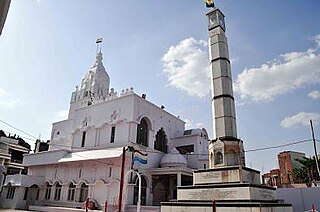
The Songadh Jain temple is a historical temple complex in the town of Songadh, in Bhavnagar district the Saurashtra region in Gujarat, India. It is 8 km from Sihor town and 28 km from Bhavnagar town.

ISKCON Temple Chennai, also known as the Sri Sri Radha Krishna Mandir, is a Gaudiya Vaishnavism temple in Chennai, India. The temple is dedicated to Hindu god Radha and Krishna. It was formally inaugurated on 26 April 2012.
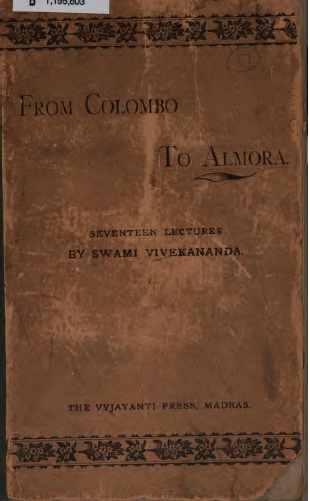
Lectures from Colombo to Almora (1897) is a book of Swami Vivekananda based on the lectures he delivered in Sri Lanka and India after his return from the West. Vivekananda reached Colombo, British Ceylon on 15 January 1897. After delivering lectures in Colombo and Jaffna, Vivekananda arrived at Pamban in South India. A forty-feet high monument was built by the king of Ramnad, Bhaskara Sethupathi, on the spot where he landed to celebrate his achievements at the West. Vivekananda travelled extensively and visited many Indian states delivering lectures on a variety of topics. On 19 June 1897, he reached Almora. The lectures delivered by him in this period were compiled into the book Lectures from Colombo to Almora.

The Swami Vivekananda statue is a bronze statue of the Hindu Indian monk Swami Vivekananda (1863–1902), located in Golpark neighbourhood in the Indian city of Kolkata. The original statue, made of marble and unveiled in 1966, was the oldest statue of Swami Vivekananda in the city. The old statue was replaced by a new, taller one in 2005.

Bahujana sukhaya bahujana hitaya cha is a dictum or aphorism enunciated in the Rigveda in Sanskrit.
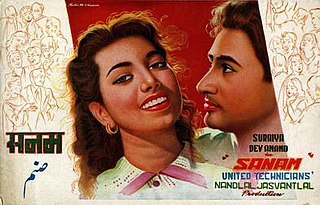
Sanam is a 1951 Bollywood romantic film directed by Nandlal Jaswantlal, who also directed the classic Anarkali. It starred Dev Anand, and his co-star was Suraiya, who also recorded the playback singing for the film. Meena Kumari acted in the film in a supporting role, where she played the role of Suraiya's best friend. The film was unsuccessful at the box office, which attributed to Suraiya's fading stardom in the early 1950s, and Madhubala's and Nargis' simultaneous rise as the top female stars.

The Jain Temple in Alleppey is a place of worship for Jains in the southern Indian state of Kerala. It was important in the growth of Jainism in South India. It is situated at the Northeast side of the Muppalam at the famous Gujarati Street in Alleppey town.

Venkateswara Temple is a Vaishnavite temple situated in the town of Dwaraka Tirumala of Eluru district of the Indian state of Andhra Pradesh. The temple is dedicated to Lord Venkateswara, an incarnation of Vishnu. The temple is also known by other name like Chinna Tirupati meaning Small Tirupati.
Uganda Cup 2018 was the 44th season of the main Ugandan football Cup.
















